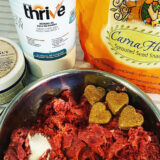What Can Ketogenic Diets Mean for Your Companion Animal?

Many of you have probably heard about the recent “trendy” ketogenic (keto) weight loss diet for humans (a variation of this diet popped up in the last few decades as the Atkins Diet). It is otherwise known as a Low Carbohydrate/High Fat/Adequate Protein diet or lifestyle. The ketogenic diet, as it is known today, was developed in the 1920s at the Mayo Clinic to treat epilepsy. However, fasting, which mimics ketogenic-type diets, has been used by humans in attempts to treat illness since 500 B.C.
What is a ketogenic or “keto” diet?
The mammalian body (be it human, canine, feline, etc.) has two major metabolic pathways involved in energy production. The body’s main two pathways use either glucose (sugar derived from carbohydrates, and in some cases protein/amino acids through a process called gluconeogenesis) or ketones (derived from fat) to power its cells. We generally think of the glucose pathway as the “standard” pathway for bodies to derive energy.
The ketogenic pathway has been viewed as a “starvation” pathway for a long time as it is the pathway that is activated during fasting/starvation. Following the initial research in the 1920s, ketogenic diets lost favour as anticonvulsant drugs were developed and ketosis was replaced by pharmaceuticals. However, ketogenic diets have had a large resurgence in the scientific literature over the past 20 years as it is being studied to treat everything from development and behavior, to diabetes, autism, Multiple Sclerosis, Parkinson’s Disease and some cancers. The basis of the ketogenic diet is to activate the fat burning, ketogenic, pathway by drastically reducing carbohydrate intake, increasing fat intake and ensuring an adequate protein intake. Ketosis is generally achieved by consuming a diet with total calories derived from macronutrients (macro or macros) in ratios of approximately 5% carbs/75% fats/20% protein.
Pet Food Diets vs. Ancestral/Natural Diet
The vast majority of pet food diets in the market are “kibble” or “dry food” diets. Nutritionally, these diets can have macro ratios anywhere from 50%+ carbs/23% fat/15% protein (like many prescription veterinary diets), to 15% carbs/15% fat/44% protein in a boutique weight-loss pet food brand, to 23% carbs/17% fat/35% protein in an above average boutique brand. These macro ratios are nowhere near that of a ketogenic diet. Given today’s pet food marketplace, how close are they to an actual ancestral or wild dog/cat diet? And what are the macro ratios in an average pre-made commercial raw food diet?
In the wild, wolves choose a 1% carb/45% fat/54% protein diet (very close to keto, but higher in protein), while several domesticated dog breeds that were also studied (papillon, miniature schnauzer, cocker spaniel, Labrador retriever, and St. Bernard) chose very similar diets comprising 7% carbs/63% fat/30% protein – very close to a strict ketogenic diet.
Free roaming cats choose a diet that consists of 2% carbs/46% fat/52% protein, while domesticated cats choose a diet comprising of 12% carbs/36% fat/52% protein.
The feeding habits and metabolism of these two carnivorous species (wolves vs. wild cats) is, however, very different. Wolves face many more extremes in food availability ranging from feast to famine. Canines are much more effective at conserving body proteins as they will down-regulate enzymes utilized in amino acid catabolism during periods of famine. This means that enzymes in the body that would normally be breaking down muscle and other important tissues into amino acids (the building blocks of protein) are significantly decreased, allowing the canine to maintain muscle (as you will see below in regard to Oscar the fasted dog). Felines, on the other hand, are less capable of withstanding famine and maintain high levels of amino acid catabolizing enzymes for gluconeogenesis (conversion of protein/amino acids to glucose i.e. sugar). When packs of wolves have access to large amounts of prey, they will consume up to 22% of their body weight at one time, however, wild cats eat many small prey meals in any given day rarely consuming more than 1% of their body weight at one time. Furthermore, wolves encounter more frequent periods of famine. They have been witnessed scavenging bones and hides for up to 10 weeks. This has made the canine body much more suited to ketogenesis. During periods of low food availability, dogs can very effectively utilize fat stores and it is estimated that ketone bodies contribute from 7% (overnight fast) to 13% (10 days of starvation) to energy production. These methods of eating can teach us a little about more appropriate ways to feed our companion animals. Obviously, dogs would love to eat, and eat and keep eating as this is their nature, so if your dog overeats they are capable of fasting for several days (don’t force them to eat regularly scheduled consistently sized meals). On the other hand, feeding your feline companion many small meals per day much more closely matches their feeding preference.
Raw food diets (known as BARF diet or meat/organ/bone diets) have become very popular for our companion animals, especially over the past 20 years as consumers have started questioning the nutrition and safety of mainstream pet food brands (although these pet foods remain a multi-billion dollar a year industry). On a dry matter basis (the percentage of nutrients calculated when all of the moisture is removed which can be used to compare all types of diets including kibble, canned, raw etc.), pre-made raw food diets look like this from a carb/fat/protein macro perspective (*samples taken from several commercially available raw food diets comparing chicken-based formulas and based on publicly available information):
a) 7.47%/30.47%/57.22
b) 3.67%/36.67%/53.33%
c) 8.59%/59.82%/31.59%
d) 9.18%/46.56%/34.69%
e) 5%/24.38%/42.19%
f) 11.79%/28.57%/57.14%
Most of these commercially available raw food diets have macro profiles that fall outside of the diet of choice for both wild wolves and domestic canines (higher in carbohydrates, lower in fat, and higher in protein), and none would be strictly ketogenic in nature. Is there room for improvement and changes in what we are feeding our companion animals even beyond these commercially available “species appropriate” diets?
 Ketogenic Diets: Actions and Benefits
Ketogenic Diets: Actions and Benefits
A recent documentary “The Dog Cancer Series: Rethinking the Canine Epidemic” by Rodney Habib and Dr. Karen Becker has brought to light the benefits of a ketogenic diet, specifically for tackling cancer in dogs. After discovering cancer in one of his dogs, Rodney (who had been feeding raw, organic, ethically raised, complete homemade raw food diets) went on a crusade to find out better ways to fight cancer and he came upon the Keto Pet Sanctuary and ketogenic diets.
The Keto Pet Sanctuary utilizes ketogenic diets to help cancer-stricken dogs that have mostly been abandoned and what they have found is quite amazing.
To start, in a cancerous state, protein in the ketogenic diet must be managed as certain amino acids (i.e. glutamine) are a favourite of cancer cells for nutrition. This is a key factor in the diet. However, ketosis, with proper macro ratios in many cases can inhibit cancer cell growth. Cancer cells express abnormal metabolism characterized by increased glucose consumption created by genetic mutations and mitochondrial (the powerplants of cells) dysfunction. Studies indicate that unlike healthy tissues, many types of cancer cells are unable to effectively use ketone bodies for energy. Furthermore, ketones inhibit the proliferation and viability of cultured tumour cells.
Other benefits of ketosis include:
- An increase in “autophagy” (literally self-eating) – whereby cells actually scavenge “old and broken parts” and even cancer cells. (This is the body’s natural cleansing system.)
- An increase in mitochondrial function – Mitochondria are the powerplants in cells, and ketosis increases mitochondrial density therefore increasing available energy.
- Reduced inflammation – helps to prevent inflammatory diseases like arthritis, skin and bowel conditions.
- Prevention of heart disease through reductions in blood pressure, triglycerides and better cholesterol profiles.
- Keeping uric acid levels in check to prevent kidney disease.
- Curbing diabetes, obesity and other metabolic disorders through reduction in requirements for glucose.
Ketosis and Fasting
As mentioned, ketogenic diets mimic the metabolic effects that occur during fasting. Fasting is actually a key component of a healthy life, especially for omnivores and carnivores (herbivores cannot be fasted). We often hear “My dog doesn’t want to eat! He/she needs to eat.” In reality, feeding your dog scheduled regular meals reduces their ability to go into ketosis and utilize BOTH of their metabolic pathways (approximately 80%+ of humans in North America have also lost this ability). As we discussed above, wolves go through continual cycles of feast and famine, and their domesticated cousins are perfectly designed to resist prolonged bouts of famine. The longest fast on record was by a Scotch collie named Oscar – 117 days before any signs of muscle wasting. So, if your dog doesn’t want to eat…he/she doesn’t need to! Let ketosis do its thing. According to Dr. Joseph Mercola, if you are not fasting your dog on a regular basis, you are doing it a disservice and not contributing to the longest and healthiest life you could be.
Overall, ketogenic diets with proper macronutrient ratios (or as close as available) and ketosis have a key role in overall health. Choosing a diet for your companion animal that is closest in macros to one that they would naturally choose and cycling through fasts and more ketogenic options can lead to longer life and better overall health for both humans and canines alike.
By P. Andrew Outinen M.Sc., M.B.A.
Owner of Tail Blazers Etobicoke and Tail Blazers Heartland (Mississauga)
About the author:
I come from a 20 year career in the human health care field. Combined with my formal, post-high school education, I have spent more than half of my life studying, researching and promoting many of our amazing advancements in research, science and medicine. I have a Bachelor of Science in Pharmacology and Toxicology. I have a Master of Science in Medical Sciences. I am a published researcher. I have been a basic researcher, clinical researcher, and heavily involved in the sales and promotion of some of the most important medical devices we as humans have ever invented. I have chosen to own Tail Blazers stores because there is nothing more fulfilling than improving the life of a companion dog or cat.









